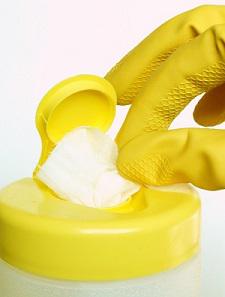Five Important Things to Know as You Disinfect
University of Arizona Cooperative Extension
Apr. 14, 2020

1. Know the difference between cleaning, disinfecting, and sanitizing.
- Cleaning removes some germs, debris, and dirt from surfaces or objects. Soap and water significantly improves the physical removal of germs from surfaces.
- Disinfecting kills germs on surfaces or objects. Disinfecting alone will not clean dirty surfaces but disinfecting after cleaning further lowers the risk of spreading infectious germs. Disinfectant wipes are registered pesticides as they are designed to kill, or inactivate microbes.
- Sanitizing lowers the number of viable germs on surfaces or objects. Don’t mistake hand sanitizers for surface sanitizers, the products are NOT interchangeable.
- Disinfectants and surface sanitizers are EPA registered antimicrobial pesticides. Real labels carefully and follow directions exactly to ensure effective use. Disinfectants kill more germs than sanitizers.
2. Clean and disinfect surfaces and objects that are touched often.
- Clean and disinfect surfaces and objects that are touched often, and undertake both steps daily. Include desktops, countertops, door handles, computer mouse and keyboards, faucets, and phones.
- Use gloves when touching surfaces and items contaminated with bodily fluids (e.g., used tissues), bag and throw soiled items away in an outside trash receptacle.
3. Always follow label directions on cleaning products and disinfectants.
- Wash surfaces with a detergent to remove dirt. Warm water, soap, microfiber cloths, and some physical effort is a magical combination that greatly aids the physical removal of germs and breakdown of some.
- Rinse with clean water and dry. This facilitates the removal of even more germs and detergent residues.
- Apply an EPA-registered disinfectant that is approved to kill SARS-CoV-2, the novel coronavirus that causes COVID-19, following label directions exactly. Disinfection usually requires the product to remain on the surface for a certain period of time (e.g., letting it stand for 3 to 5 minutes), and some products need to be removed with clean water. Follow label directions exactly.
4. Understand product safety warnings.
- Products have specific directions on labels and hazard warnings. Chemically protective gloves and eye protection is advisable and may be legally required if stipulated on the label.
- Never allow children to use disinfectants or disinfectant wipes.
- Do not mix cleaning agents or multiple detergents with disinfectants unless the label explicitly states that it is safe to do so. Combining products can result in serious injury or death. Mixing chlorine bleach and ammonia cleaners produces potentially lethal chlorine gas. Please note that, commonly used products contain bleach (hypochlorite) and ammonia e.g., toilet bowl cleaners often contain bleach, and window cleaners often contain ammonia.
- Ensure that anyone using cleaners and disinfectant products have access to product labels in a familiar language, and have read and understand the labels.
5. Know how to handle solid waste.
- Follow standard institutional procedures for handling waste, which may include wearing gloves. Place no-touch wastebaskets where they are easy to use. Avoid touching used tissues when emptying wastebaskets, or wear gloves if tissues must be handled. Wash your hands with soap and water after processing waste and removal of disposable gloves.

